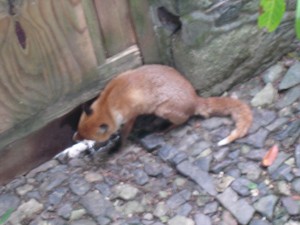Urban Foxes: Pest or Pleasure?
 Recently I was on my way back from a wedding, it was just after midnight, and I saw five foxes. Two of these foxes were in the town of Tavistock, Devon, UK; the other three were in the countryside in between Okehampton and Halwill Junction. These sightings got me thinking, are these foxes pests and annoying animals, or was I privileged to see them?
Recently I was on my way back from a wedding, it was just after midnight, and I saw five foxes. Two of these foxes were in the town of Tavistock, Devon, UK; the other three were in the countryside in between Okehampton and Halwill Junction. These sightings got me thinking, are these foxes pests and annoying animals, or was I privileged to see them?
Foxes can be found all over the world. There are also many different fox species; kit foxes, swift foxes and arctic foxes are just a few.
In cities urban foxes are often considered a pest, an annoying animal that rips up rubbish and wakes many people up. Yes, it’s true foxes (vixens especially) do have a startling shrieking scream that is enough to scare many people, but should city-people be privileged that there’s wildlife ‘on their doorstep’?
In fact there is believed to be a more stable population of foxes living in urban areas than in the rural countryside. Surprising really – especially as many people think foxes are a lot more common in the countryside. Foxes are far less common in rural areas mainly due to a disease, sarcoptic mange, that spread across mainland Britain in the 1990s. Reports have shown that this disease may have wiped out as many as 95% of countryside foxes, but the numbers of rural foxes are gradually increasing.
Despite what many people think, foxes only became widespread in cities such as London and Bristol in the 1940s. In many cases urban foxes are not the scavenging creatures people think they are; recent studies have shown that the diet of an average city fox is mainly made up of food that is deliberately put out for them. Of course, foxes will still rip bin bags to get at food that’s been thrown out if it is available – after all they’re animals and they’ve got to eat.
In a recent survey, it was revealed that 2.7% of households (out of 5480 households) said that their bins were frequently rifled by foxes, and 80.9% had never been bothered by foxes scavenging from their bins. It is a common misconception that these animals only eat from bins; after all you only hear about people complaining about their bins being rifled, not those whose bins have been left alone.
Many foxes are also unable to knock over dustbins – yet you see many images in magazines of them looking inside a dustbin they’ve just knocked over; many of such images have been set up and are not natural. The most likely way a fox would feed from a bin is to knock the lid off, then jump up inside the bin. Foxes are quite small animals, about the size of small to medium dogs, although they vary in size a lot. They have very powerful, strong back legs that allow them to jump incredible high and kick powerfully.
 Foxes will also catch a large number of ‘vermin animals’ in cities too, so they’re reducing the numbers of ‘undesirable wild mammals’. A large proportion of their diet is also made up of berries and fruit. Foxes will also prey on wild rabbits and birds among other creatures.
Foxes will also catch a large number of ‘vermin animals’ in cities too, so they’re reducing the numbers of ‘undesirable wild mammals’. A large proportion of their diet is also made up of berries and fruit. Foxes will also prey on wild rabbits and birds among other creatures.
Wherever you live, if you have any pets that foxes will try to catch, you should make sure they are in a secure place and not at risk from foxes. After all, foxes are predators.
A lot of people who live in cities try to attract foxes to their back gardens to watch their local wildlife. If you repeatedly put out food it is likely that foxes will keep coming back.
Like all animals, foxes do have a tendency to be dangerous and will carry out threatening behaviour if they feel threatened, so you have to respect them as you would all animals.
Going back to the foxes I saw, the two in the town seemed more lean and were a darker grey in colour, than the three I saw in the countryside. The first one was walking down the middle of a road just past a roundabout – this is probably because it was the best place to see most of its surroundings. The second was just up the road and was sitting on the pavement; when I was about 50 feet from it, it sprang up and jumped over a 4ft stone wall. Both of these foxes looked grey in colour and quite lean, although the colour could be caused by the street-lights.
The three foxes in the countryside were a softer, more orange colour and were definitely shyer. As soon as they saw the vehicle coming they were off in a flash, two darting across the road, and one pouncing back into the hedge it had come out of.
On the farm where I live, there is a den of foxes that has pups in every spring and I feel it a privilege to watch them.
 October 26, 2010
В·
October 26, 2010
В·  Maddia (Admin) В·
Maddia (Admin) В·  Comments Closed
Comments Closed
 Tags: foxes, foxes pest, scavenging foxes, urban foxes, urban foxes: Pest or Pleasure В· Posted in: Foxes, My Wildlife Watch
Tags: foxes, foxes pest, scavenging foxes, urban foxes, urban foxes: Pest or Pleasure В· Posted in: Foxes, My Wildlife Watch


